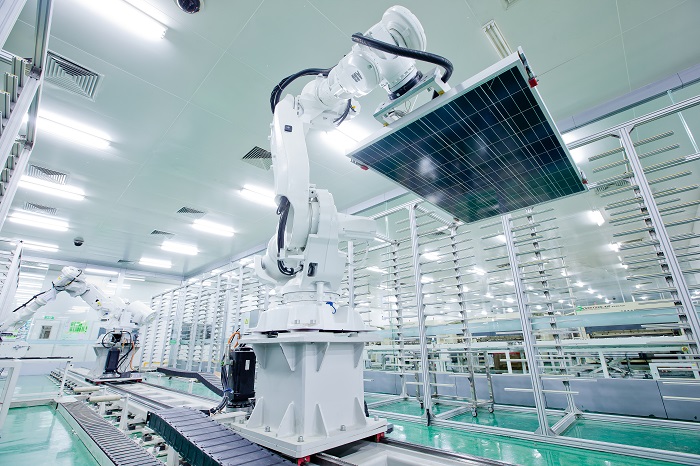From pv magazine, September edition
The energy gain from bifacial module technology has been proven to range from single-digit percentages to more than 20%, compared with monofacial modules, depending on a wide array of variables, some participants at the 2018 bifiPV Workshop noted.
“Bifacial modules represent the largest step function improvement in project economics for minimal technology risk since the introduction of trackers,” says Jenya Meydbray, Vice President of Solar Technology at Cypress Creek Renewables, based in San Francisco.
The meeting was the fifth and last workshop to be held in the U.S., hosted by the National Renewable Energy Laboratory (NREL), and Germany’s International Solar Energy Research Center Konstanz (ISC Konstanz). Participants discussed the bankability of bifacial technology, the LCOE with bifacial, and the modeling and qualification of the technology, primarily on single-axis trackers.
Surprising field performance
One standout installation utilizing bifacial was touted during the workshop: the 1.25 MW array developed with PVG Solutions’ EarthON modules at Asahikawa, Japan, which has demonstrated a bifacial gain of nearly 20% – the world record thus far, observes Radovan Kopecek, Deputy Chair of the Executive Board of ISC Konstanz.
Bifacial panel makers are enthusiastic about obtaining higher yields over the short term. “If we can get a 20% bifacial factor, then the sky is the limit,” says Ashok Sinha, CEO of Sunpreme. The Sunnyvale, California-based producer of bifacial modules is planning a 400 MW factory.
With an energy yield that is 20% higher, bifacial tracker project developers will be able to get more projects built because of better economics, and because Northern climes offer the highest albedo, or ground reflection, over snow, maximizing the bifacial yield.
Although bifacial technology may cost $0.05/W more to install than a monofacial PV system, a conservative 10% bifacial gain easily outweighs the risk, notes Scott Stephens, Director of Technology Development at Clearway Energy, formerly NRG Renew, in San Francisco.
NREL estimates that the market share for bifacial tracker systems will expand from a near-zero base today to a projected 10% market share in 2019, and 30% by 2025, compared with monofacial panels. Michael Woodhouse, an economic analyst at NREL, calculates that this would make the technology a multi billion dollar industry by itself. “That would represent a $20 billion to $110 billion market for bifacial technology,” he says.
Standards for benchmarking
While the current-voltage field testing of bifacial panels on trackers began several years ago, a consensus vote is still out on exactly what the performance test standards should be. Once an international test standard is adopted, the industry can adopt performance benchmarks that will inform commercial choice.
Among key tests for bifacial panels is the flash test that grades the yield potential of the back side of the panel as a percentage of the front side. Depending on the cell production, the bifacial factor as measured in a laboratory can range from 50% to 95%, Kopecek says. In the field, that factor frequently hits 15% now, and is expected to rise well into the 20% range as developers learn how to adapt installation variables to optimize yield, he adds. The workshop participants outlined a long list of these variables under study now.
Work to establish an international standard for bifacial panel flash testing has been ongoing for the last few years, and an internal draft of the International Electrotechnical Commission’s IEC 60904-1-2 was circulated among participants of the U.S. PV industry working group in May. A public version is expected to be released in January 2019, says Chris Deline, the engineering researcher at NREL helping to organize the national effort.
|
Surface type |
Albedo |
|
Greenfield (grass) |
23% |
|
Concrete |
16% |
|
White-painted concrete |
60-80% |
|
White gravel |
27% |
|
White roofing metal |
56% |
|
Light-gray roofing membrane |
62% |
|
White roofing membrane |
> 80% |
|
Source: LONGi Solar |
|
By Charles Thurston
This content is protected by copyright and may not be reused. If you want to cooperate with us and would like to reuse some of our content, please contact: editors@pv-magazine.com.








1 comment
By submitting this form you agree to pv magazine using your data for the purposes of publishing your comment.
Your personal data will only be disclosed or otherwise transmitted to third parties for the purposes of spam filtering or if this is necessary for technical maintenance of the website. Any other transfer to third parties will not take place unless this is justified on the basis of applicable data protection regulations or if pv magazine is legally obliged to do so.
You may revoke this consent at any time with effect for the future, in which case your personal data will be deleted immediately. Otherwise, your data will be deleted if pv magazine has processed your request or the purpose of data storage is fulfilled.
Further information on data privacy can be found in our Data Protection Policy.